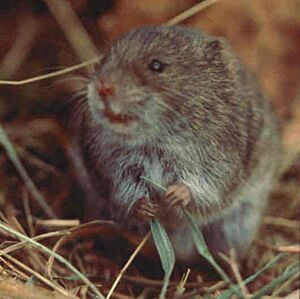Beach vole facts for kids
Quick facts for kids Beach vole |
|
|---|---|
 |
|
| Conservation status | |
| Scientific classification | |
| Genus: |
Microtus
|
| Species: |
breweri
|
| Synonyms | |
|
|
The beach vole (Microtus breweri), also known as the Muskeget vole, is a small rodent that belongs to the Cricetidae family. It is a close relative of the eastern meadow vole (Microtus pennsylvanicus). This special animal lives only on Muskeget Island, Massachusetts, which is a small island about 0.87 square kilometers (0.34 square miles) in size.
Scientists sometimes debate if the beach vole is its own unique species or a special type (called a subspecies) of the eastern meadow vole. This is because they haven't been separated for a very long time.
What Makes Them Special?
Scientists like the IUCN and NatureServe currently recognize the beach vole as its own species. This is because it is larger than the meadow vole, lives in a specific isolated place, and has different mating habits. Some recent studies suggest it might be a very old subspecies of the meadow vole.
Appearance
Beach voles are usually much bigger than meadow voles.
- Male beach voles are about 19.3 centimeters (7.6 inches) long on average. Their tails make up about a quarter of their total length.
- Female beach voles are a bit smaller, averaging about 18.1 centimeters (7.1 inches) long.
- They weigh between 29 and 79 grams (1 to 2.8 ounces). Older voles are heavier, and males usually weigh more than females.
Their fur coat is different from meadow voles. It has more stiff outer hairs and fewer soft underhairs. Sometimes, you can spot a white patch on their chin or forehead.
The skull of a beach vole is also different from a meadow vole's. Beach voles have larger skulls. Their brain case is longer and narrower. These skull differences help scientists tell the two types of voles apart.
Because they live on an island, beach voles tend to grow larger than their relatives on the mainland. This is a common thing that happens to animals on islands, sometimes called island gigantism.
Where They Live
The beach vole can only be found on Muskeget Island, which is off the west coast of Nantucket, Massachusetts, in the United States. In the past, they also lived on nearby South Point and Adams Islands. These islands are now underwater or connected to Muskeget Island.
The beach vole population on Muskeget Island almost disappeared around 1891. This happened because of cats that were living wild on the island. But in 1893, scientists brought voles from South Point Island back to Muskeget Island, helping the population recover.
Muskeget Island itself has changed a lot over the last 200 years. It has moved eastward by about 300 meters (1,000 feet). Its shape, size, and position are always changing because of erosion and sand building up from the tides.
Home and Food
Beach voles mostly live in open areas filled with poison ivy and beach grass. They try to avoid areas of bare sand or salt marsh. They often dig burrows in loose sand or soil. These burrows are usually under or near their shelters.
What do beach voles eat?
- They munch on the stalks, leaves, and seeds of beach grass.
- They also eat adult insects and their larvae (young insects).
Who hunts the beach vole?
- Birds of prey are their main predators. These include the short-eared owl and the northern harrier.
- Wild cats were a big problem in the late 1800s, causing the vole population to drop sharply. Luckily, there are no longer any wild cats on Muskeget Island.
A beach vole's home range, the area where it lives and finds food, is usually smaller than one acre.
How They Live and Behave
Young beach voles are born in burrow nests. These nests are often found under pieces of debris or at the base of goldenrod plants. Female beach voles usually have two litters of three to five babies each year. Their gestation period (how long they are pregnant) is about one month. Most beach voles live for less than one year.
Beach voles are very clever at staying hidden from birds that hunt from the sky. They build special "runways" either above ground or just under the beach grass. These runways help them move around without being seen. You might even find cut grass along these paths. During the cold winter months, they tend to use underground tunnels more often to stay warm.



